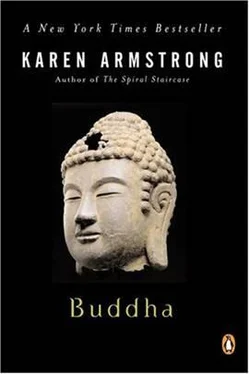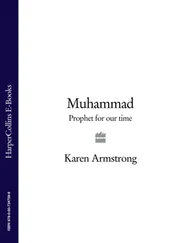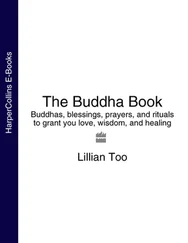What are we to make of this misogyny? The Buddha had always preached to women as well as to men. Once he had given permission, thousands of women became bhikkhunls, and the Buddha praised their spiritual attainments, said that they could become the equals of the monks, and prophesied that he would not die until he had enough wise monks and nuns, lay men and lay women followers. There seems to be a discrepancy in the texts, and this has led some scholars to conclude that the story of his grudging acceptance of women and the eight regulations was added later and reflects a chauvinism in the Order. By the first century b.c.e., some of the monks certainly blamed women for their own sexual desires, which were impeding them from enlightenment, and regarded women as universal obstacles to spiritual advance. Other scholars argue that the Buddha, enlightened as he was, could not escape the social conditioning of the time, and that he could not imagine a society that was not patriarchal. They point out that, despite the Buddha’s initial reluctance, the ordination of women was a radical act that, perhaps for the first time, gave women an alternative to domesticity.
While this is true, there is a difficulty for women that should not be glossed over. In the Buddha’s mind, women may well have been inseparable from the “lust” that made enlightenment an impossibility. It did not occur to him to take his wife with him, as some of the renouncers did, when he left home to begin his quest. He simply assumed that she could not be the partner in his liberation. But this was not because he found sexuality disgusting, like the Christian Fathers of the Church, but because he was attached to his wife. The scriptures contain a passage which, scholars agree, is almost certainly a monkish interpolation. “Lord, how are we to treat women?” Ananda asked the Buddha in the last days of his life. “Do not look at them, Ananda.” “If we do not see them, how should we treat them?” “Do not speak to them, Ananda.” “And if we have to speak to them?” “Mindfulness must be observed, Ananda.” The Buddha may not have personally subscribed to this full-blown misogyny, but it is possible that these words reflect a residual unease that he could not overcome.
If the Buddha did harbor negative feelings about women, this was typical of the Axial Age. Sad to say, civilization has not been kind to women. Archeological discoveries indicate that women were sometimes highly esteemed in pre-urban societies, but the rise of the military states and the specialization of the early cities led to a decline in their position. They became the property of men, were excluded from most professions, and were subjected to the sometimes draconian control of their husbands in some of the ancient law codes. Elite women managed to hold on to some shreds of power, but in the Axial countries women suffered a further loss of status at about the time that the Buddha was preaching in India. In Iran, Iraq, and, later, in the Hellenistic states, women were veiled and confined in harems, and misogynistic ideas flourished. The women of classical Athens (500-323) were particularly disadvantaged and almost entirely secluded from society; their chief virtues were said to be silence and submission. The early Hebrew traditions had exalted the exploits of such women as Miriam, Deborah and Jael, but after the prophetic reform of the faith, women were relegated to second-class status in Jewish law. It is notable that in a country such as Egypt, which did not participate initially in the Axial Age, there was a more liberal attitude to women. It seems that the new spirituality contained an inherent hostility toward the female that has lasted until our own day. The Buddha’s quest was masculine in its heroism: the determined casting off of all restraints, the rejection of the domestic world and women, the solitary struggle, and the penetration of new realms are attitudes that have become emblematic of male virtue. It is only in the modern world that this attitude has been challenged. Women have sought their own “liberation” (they have even used the same word as the Buddha); they too have rejected the old authorities, and set off on their own lonely journey.
The Buddha predicted that women would blight the Order, but in fact the first major crisis in the Sangha was caused by a clash of male egos. According to Buddhist principles, a fault is not culpable unless the perpetrator realizes that he has done wrong. In Kosambi, a sincere and learned monk was suspended, but protested that his punishment was unfair, since he had not realized that he was committing an offense. The Kosambi bhikkhus at once divided into hostile factions and the Buddha was so distressed by the schism that at one point he went off to live by himself in the forest, forming a friendship with an elephant who had also suffered from aggressive peers. Hatred, the Buddha said, was never appeased by more hatred; it could only be defused by friendship and sympathy. He could see that both camps had right on their side, but the egotism of all the bhikkhus involved made it impossible for them to see the other point of view, even though the Buddha tried to make each faction understand the position of the other. He told Sariputta and Pajapati, now head of the women’s Sangha, to treat both sides with respect; Anathapindika was instructed to give donations impartially to both camps. But the Buddha did not impose a solution: the answer must come from the participants themselves. Eventually, the suspended bhikkhu climbed down; even though he had not known it at the time, he had committed a fault. Immediately, he was reinstated and the quarrel came to an end.
The story tells us a good deal about the early Sangha. There was no tight organization and no central authority. It was closer to the sanghas of the old republics, where all the members of the council were equal, than to the new monarchies. The Buddha refused to be an authoritative and controlling ruler, and did not resemble the Father Superior of later Christian religious orders. Indeed, it was probably inaccurate to speak of an Order; there were rather a number of different orders, each of them situated in a particular region of the Ganges basin. Nevertheless, the members all shared the same Dhamma and followed the same lifestyle. Every six years, the scattered bhikkhus and bhikkhunis would come together to recite a common confession of faith, called the Patimokkha (“bond”). As its name implies, its purpose was to bind the Sangha together:
Refraining from all that is harmful, Attaining what is skillful, And purifying one’s own mind; This is what the Buddhas teach.
Forbearance and patience are the highest of all austerities;
And the Buddhas declare that Nibbana is the supreme value.
Nobody who hurts another has truly “Gone Forth” from the home life.
Nobody who injures others is a true monk.
No faultfinding, no harming, restraint, Knowing the rules regarding food, the single bed and chair,
Application in the higher perception derived from meditation-
This is what the Awakened Ones teach.
The Buddha attached great importance to this ceremony, which corresponded to the plenary assemblies that had characterized the republics. Nobody was allowed to miss the Patimokkha, since it was the only thing that held the early Sangha together.
Much later, after the Buddha’s death, this simple recitation was replaced by a more elaborate and complex assembly, held by each local community in each region once a fortnight, on the uposatha days. This change marked the transition of the Sangha from a sect to an Order. Instead of chanting the Dhamma, which distinguished them from the other sects, the monks and nuns now recited the rules of the Sangha and confessed their transgressions to one another. By this time, the Sangha’s regulations were more numerous than they had been in the Buddha’s day. Some scholars argue that it took two or three centuries for the Rule, as recorded in the Vinaya, to take its final form, but some believe that, at least substantially, the spirit of the Order can be traced back to the Buddha himself.
Читать дальше












